 |
|||||
|
|||||
| Preview of Stamps Catalogue: VOLUME 1 |
 |
|||||
|
|||||
| Preview of Stamps Catalogue: VOLUME 1 |
Return To Catalogue - 1854 issue - 1855-1865 issues - 1902-1935 issues - Indian states: Alwar, Bamra, Bhor, Bhopal part 1 - Indian States: part 2 - Indian States: part 3 - Indian States part 4 - Chamba - Nabha - Faridkot - Gwalior - Jhind - Patiala (Puttialla) - Miscellaneous
Note: on my website many of the
pictures can not be seen! They are of course present in the catalogue;
contact me if you want to purchase it.
For issues of issued before 1866 click here.
9 p lilac 4 a green 6 a brown 6 a 8 p grey 12 a brown 1 R grey
Value of the stamps |
|||
vc = very common c = common * = not so common ** = uncommon |
*** = very uncommon R = rare RR = very rare RRR = extremely rare |
||
| Value | Unused | Used | Remarks |
| 9 p lilac | *** | *** | For 9 p red with "INDIA POSTAGE" see next issue. |
| 4 a | R | * | |
| 6 a | *** | * | |
| 6 a 8 p | RR | R | |
| 12 a brown | R | *** | For 12 a lilac on red with "INDIA POSTAGE" see next issue. |
| 1 R | RR | *** | |
Official stamps; overprinted 'Service' (1866)
4 a green ('Service' small)
4 a green ('Service' large)
6 a 8 p grey ('Service' large)
Value of the stamps |
|||
vc = very common c = common * = not so common ** = uncommon |
*** = very uncommon R = rare RR = very rare RRR = extremely rare |
||
| Value | Unused | Used | Remarks |
| 4 a | RRR | RR | 'Service' small |
| 4 a | *** | * | 'Service' large |
| 6 a 8 p | RRR | - | Non issued? |
Official stamp; overprinted "On H.M.S."

4 a green
Value of the stamps |
|||
vc = very common c = common * = not so common ** = uncommon |
*** = very uncommon R = rare RR = very rare RRR = extremely rare |
||
| Value | Unused | Used | Remarks |
| 4 a | *** | * | |
For the specialist: all these stamps have watermark 'Elephant Head' and perforation 14.

Overprinted with crown and "TWELVE CENTS" used in Straits Settlements 1867
I've seen the values 4 a and 6 a 8 p with "CANCELLED" overprint similar to the 1855 issue of India.


(Typical cancels, reduced views)

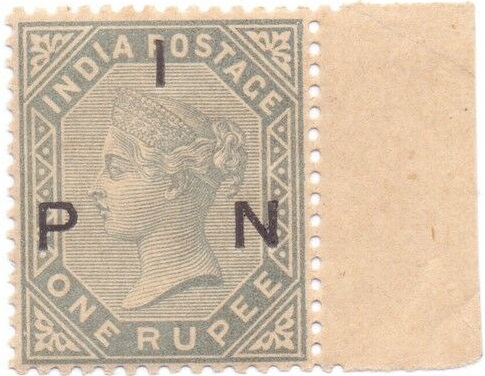
With "I P N" overprint and "Rs 2, As8"
surcharge, used as Indian Postal Note. The "IPN"
overprint also exist on the 1 R value and on a 8 a stamp of the
previous 1855 issue.

Fiscal stamp, 4 a overprinted "Court Fees." and
"Service" with bar.
Stamps with overprint "POSTAL SERVICE." are fiscal stamps. For this issue, "ONE ANNA" on 9 p lilac:

Even though the overprint says "POSTAL SERVICE", this
is a fiscal stamp.

1 R red and green with "CHAMPION-REEF" cancel.

(Typical cancel)
3 p red 3 p grey 9 p red 1/2 a green 1 a red 1 a brown 1 a 6 p brown 2 a blue 2 a violet 2 a 6 p green 2 a 6 p blue 3 a orange 4 a olive 4 a 6 p green 8 a lilac 12 a lilac on red 1 R grey 1 R red and green Surcharged


'1/4' on 1/2 a green (1898) '2 1/2 As' on 4 a 6 p green (1889)
The watermark on all these stamps is 'Star', the perforation is 14.
Value of the stamps |
|||
vc = very common c = common * = not so common ** = uncommon |
*** = very uncommon R = rare RR = very rare RRR = extremely rare |
||
| Value | Unused | Used | Remarks |
| 3 p red | c | c | |
| 3 p grey | c | * | A new color grey became necessary since the1 a red
now had the same color as the 3 p red. |
| 9 p red | * | * | For 9 p lilac with "EAST INDIA POSTAGE"see previous issue |
| 1/2 a | * | vc | Issued in yellowish green in 1900 |
| 1 a brown | * | c | |
| 1 a red | * | c | Color changed to adhere to the UPU color scheme. |
| 1 a 6 p | ** | * | |
| 2 a blue | *** | c | |
| 2 a violet | *** | c | Became necessary since the 2 a 6 p blue now had the
same color as the 2 a blue. |
| 2 a 6 p green | ** | c | |
| 2 a 6 p blue | *** | * | Color changed to adhere to the UPU color scheme. |
| 3 a | ** | * | |
| 4 a | ** | * | |
| 4 a 6 p | *** | ** | |
| 8 a | *** | * | |
| 12 a | *** | ** | For 12 a brown with "EAST INDIA POSTAGE" see previous issue. |
| 1 R grey | *** | * | |
| 1 R red and green | *** | * | Issued, since forgeries of the 1 R grey were discovered. |
| Surcharged | |||
| 1/4 on 1/2 a | * | * | Issued for the reduced rate of 1/4 a for newspapers.
Inverted surcharges are forgeries (see Stamps of India by J.Cooper). |
| 2 1/2 a on 4 a 6 p | ** | * | Issued since the postage for letters from India to
Great Britain was reduced from 4 a 6 p to 2 1/2 a. |
Official stamps; overprinted 'On H.M.S.'
3 p red 1/2 a green 1 a brown 1 a red 2 a blue 2 a violet 4 a olive 8 a lilac 1 R red and green
Value of the stamps |
|||
vc = very common c = common * = not so common ** = uncommon |
*** = very uncommon R = rare RR = very rare RRR = extremely rare |
||
| Value | Unused | Used | Remarks |
| 3 p | * | * | |
| 1/2 a | * | c | |
| 1 a brown | * | vc | |
| 1 a red | * | c | |
| 2 a blue | ** | c | |
| 2 a violet | *** | c | |
| 4 a | ** | c | |
| 8 a | *** | c | |
| 1 R | *** | * | |
Stamps with overprint "POSTAL SERVICE." are fiscal stamps. For this issue, the following values were overprinted: 1/2 a green, 1 a brown, 2 a blue, 2 a violet, 4 a green, "ONE ANNA" on 9 p red, 8 a lilac and 1 R red and green. See also the "ONE ANNA" on 9 p lilac overprint on the previous issue.

"ONE ANNA" on 9 p of the previous issue, 1 a, 1 a King
Edward VII and 2 R 1895 Queen Victoria issue. Even though the
overprint says "POSTAL SERVICE", these are fiscal
stamps.


14 1 R postal forgeries of 1888, images obtained thanks to Mark
Rowe. A genuine 1 a stamp was also used on this part of an
envelope. A zoom-in of one of the stamps is also shown. This
forgery is described in Leslie Fletcher's book 'Postal Forgeries
of the World' as postal forgery #1. The eye is very badly done
(too white and too large).

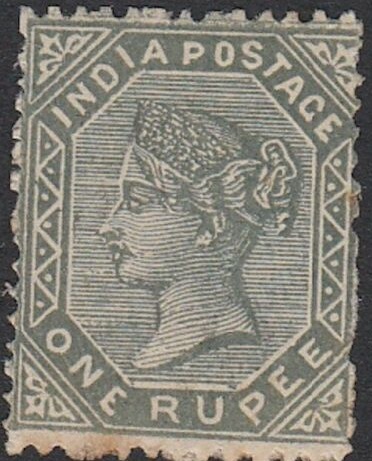
Postal forgery type #2 of Fletcher's book has the "PO"
of "POSTAGE" too small and the "O" is badly
done. In front of the chin there is a background line partly
missing. It is also known as a Sakharam postal forgery(?).


Postal forgery type #3 of Fletcher's book is only known as a die
proof (Madras forgery made by Kondu Sakharam?). It is rather
deceptive, but it has no watermark and no perforation. I've been
told that after this forgery was discovered, the stamp was
replaced by the 1 R red and green design.
In the Dominion Philatelist Vol.IV. No.41, page
63the following text can be found regarding the above forgeries:
FORGED INDIAN STAMPS.
The report of the Indian Postmaster-General for the past year
contains an interesting account of the manner in which a large
number of stamps of the value of one rupee each were forged. The
forger was a Poona Brahmin, who was formerly in the service of
the Trigonometrical Survey. He had prepared a die of the
one-rupee stamp in white stone, which was set in wood, and
thirty-nine of these dies had been made from time to time before
he succeeded in producing a sufficiently accurate representation
of the original stamp. This die was thoroughly cleaned with
kokam, or mangosteen, and then covered with an oily substance or
ink of the colour of the one-rupee stamp, which was carefully
spread over it with the finger. A piece of paper was then placed
on the die, and rubbed with a shell, and on being removed was
found to bear a wonderfully dose representation of the genuine
stamp. The stamp so produced was then placed with its face down
on a piece of metal, moistened with water, and had a watermark
die, that had been separately prepared, gently hammered upon it.
It was afterwards put upon a small square of tin, of the same
size as the genuine stamp, marked with the correct number of
holes for the purpose of perforation, and carefully perforated
with a small needle-like instrument. The whole process occupied
about ten minutes. The number of counterfeit stamps successfully
passed by the forger and his accomplices was about 1,000. The
forger and his chief accomplice, a stamp vendor, were prosecuted
in the Bombay High Court, and sentenced to ten years'
transportation each. A few of the counterfeit stamps found their
way into the Bombay Post Office through the complicity of some of
the clerks, and one of these committed suicide when the forger
was arrested. A new one-rupee stamp, combining two colors, was in
consequence introduced. It is interesting to notice that only two
frauds connected with the telegraphic money order system are
recorded in this year's report, and in one of these the person
committing the fraud committed suicide before he could be
arrested. ---- From the Times.
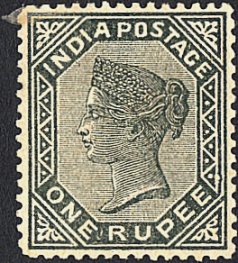
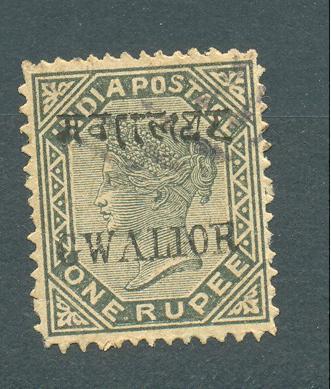
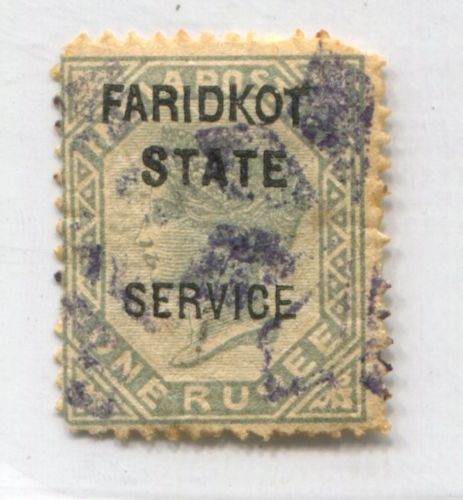
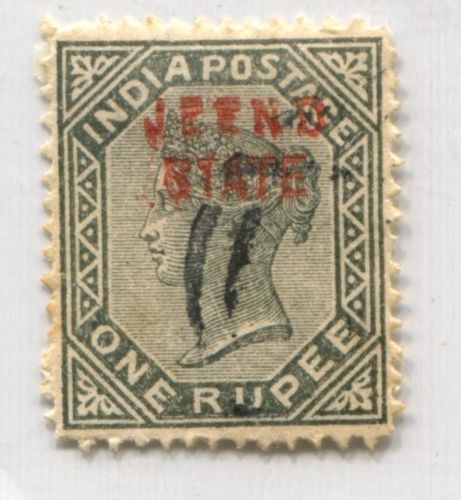


Another postal(?) forgery of the 1 R value; the 'S' of 'POSTAGE'
is slanting too much to the right. This is postal forgery #4 of
Fletcher's book. The forgery next to it with forged
"GWALIOR" overprint for Gwalior,
"FARIDKOT STATE SERVICE" for Fardikot and "JEEND
STATE" for Jhind and
"PUTTIALLA STATE" for Puttialla
could have been made by the same forger. They are very similar in
style to forgeries made by Oneglia.

Another forgery of the 1 R value with forged 'KARACHI' cancel;
probably a philatelic forgery.

Another postal forgery with awkward 'OS' in 'POSTAGE'.

Two philatelic forgeries with "NABHA STATE" printed on
them.
The forger Sperati seems to have made forgeries of the 1 R value as well. He printed it on bleached out cheaper valued stamps from the Indian States and printed his forged 1 R design on it. Sperati forgeries are very rare and quite expensive.

Fournier forged '1/4' surcharge (probably used to make forged
inverted surcharges) and a forged cancel made by the forger Fournier. Images taken from a 'Fournier
Album of Philatelic Forgeries'.

Sperati forgery of the 9 p value, here a imperforate blackprint
('proof').

Primitive forgery of the 2 a value.
2 R brown and red 3 R green and brown 5 R violet and blue
For the specialist, the watermark on the 1882 issue is 'Star', example:

(Star watermark on a 3 R stamp)
The perforation is 14 on these stamps.
Value of the stamps |
|||
vc = very common c = common * = not so common ** = uncommon |
*** = very uncommon R = rare RR = very rare RRR = extremely rare |
||
| Value | Unused | Used | Remarks |
| 2 R | R | ** | |
| 3 R | R | *** | |
| 5 R | RR | R | |
Stamps with overprint "POSTAL SERVICE." are fiscal stamps:

This overprint exists on the values 2 R, 3 R and 5 R. Even though
the overprint says "POSTAL SERVICE", these are fiscal
stamps.
3 p red 1/2 a green 1 a brown 1 a red (1902) 2 a blue 2 a 6 p green 3 a orange 4 a olive 8 a lilac 12 a lilac on red 1 R red and green
Value of the stamps |
|||
vc = very common c = common * = not so common ** = uncommon |
*** = very uncommon R = rare RR = very rare RRR = extremely rare |
||
| Value | Unused | Used | Remarks |
| 3 p | * | * | |
| 1/2 a | * | * | |
| 1 a brown | * | * | |
| 1 a red | *** | *** | |
| 2 a | *** | *** | |
| 2 a 6 p | *** | *** | |
| 3 a | *** | *** | |
| 4 a | *** | *** | |
| 8 a | *** | *** | |
| 12 a | *** | *** | |
| 1 R | *** | *** | |
These stamps are usually cancelled with "F.P.O. No" and then a number ranging from 1 to 18. Also "BASE OFFICE" exists.

"F.P.O. No 4" cancel used in Tientsin.
For stamps of India issued from 1902 to 1935, click here.